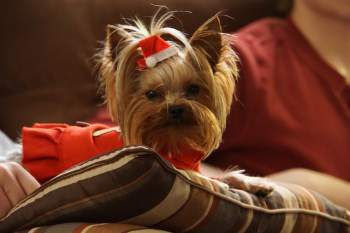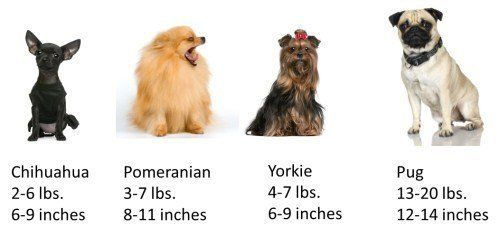Not every Yorkie grows to a tiny size. That doesn’t mean they are not purebred or less lovable? Yorkies come in all shapes and sizes just like us. Does it mean they are less of a Yorkie? No, our King was 13 lbs and he was the best dog we ever had. Does a breeder have control over weight and size? I don’t think so. We estimate on history and parents but breeders cannot predict how big or small a Yorkie grows. Genetics, food and environment play a big part in any dogs life. So that being said, a pet-parent should not look at their pets size, but look at their health and temperament. They are family, do you ban your child because it turns out bigger than you hoped for? No, we love them. Unconditionally ❤️.
Yorkie Size
Overview
There are lots of questions regarding Yorkie size. Many owners are concerned that their dog is either too small or too large in comparison to others…And this leads them to be concerned about possible health issues… Or even if breeding was done properly.
At the heart of this issue is the expression “toy” or “mini”. This is due partly because there are breeders who purposefully bred down this dog to create Yorkshire Terriers that are smaller than the standard.
The other element is a standard Yorkie that falls under or over the expected weight and/or size range.
Expected Size
Weight: Breed standards have changed. The AKC previously listed a minimum weight of 4 pounds (1.81 kg).
Now there is only a maximum weight of 7 pounds (3.17 kg) for a full grown, adult Yorkie.
Even with this change on paper, most Yorkshire Terriers fit into the 4 to 7 lb. (1.81 kg to 3.17 kg) range. A dog smaller than this, fully grown, would be considered too small and may have size related health issues.
There are however, many Yorkies that are a tad larger than the 7 lbs, weighing 8 to 10 lbs. (3.62 to 4.53 kg). If not overweight, this would be due to larger bone structure, which most likely is due to a pairing of dam and sire that was not quite correct to produce standard sized dogs.

Harper Grace, 2 years old & 3 lbs.
Photo courtesy of Stephanie Fairchild
In some instances, a Yorkshire Terrier can be dramatically larger than expected, reaching upward of 10 or even 15 pounds. How can this be? In many cases, this is a matter of another larger breed somewhere in the bloodline (more ahead).
Height: There is not a height standard set. What an owner can expect is for an adult to reach a height of between 6 and 9 inches (15.24 to 22.86 cm) and one must remember that this measurement is from the floor to the withers (shoulder tops).
With this being said, this breed can vary in both weight and height. Let’s first take a look at how the Yorkie compares to other toy breeds.

As you can see, even though the Chihuahua is the smallest of all purebred toy breeds, the Yorkie very close. In fact, the smallest dog ever on record was a Yorkshire Terrier.
Teacups
The issue of miniatures is one of great controversy. The AKC and any other reputable kennel does not recognize the Teacup or any other term that implies tiny size as an acknowledged variation of the breed or as a separate variety.
One of the reasons why the term even exists is because at some point, someone thought that if small was good, smaller was better. In time, just about every toy and small sized type of dog was bred down, despite it interfering with health.

Monique, 1 and 1/2 years old
Photo courtesy of Timo Hughes
Marketing and sales pitches will have some believing that these are “special” dogs. However, taking a 4 to 7 pound dog and purposely making it even tinier is putting the dog’s health in jeopardy. Some are as little as 2 pounds and only 4 to 5 inches at the shoulder.
The process is done by obtaining a male and a female that are both undersized and when paired together, will have a likelihood of producing tiny puppies. One should understand that 4-7 pounds is very tiny….To be any smaller creates many issues including:
Fragile bones
Weakened immune system
Greater chances of neck, hip, and knee injury
Shorter life span
For those who have a Yorkie adult that is under 3 pounds, it is advisable to keep a close eye on potential problems. Your veterinarian should be checking for issues such as luxating patella (slipped kneecap), hip dysplasia (slipped hip joint and socket) and collapsed trachea. One must stay aware of temperature changes…The Yorkie will easily overheat in hot weather and will most likely need protection in cold weather (booties, sweater, etc.)
You may remember 'Tiny Pinocchio', an unusually small Yorkie, that appeared on many TV shows including Oprah and the Today Show. He was only 1 lb and just 4.5 inches tall. It's sad how his tiny size was celebrated...he died at the age of 2 years old.
Bigger Than Normal Yorkies
Larger than average, but not uncommon: On the other end of the spectrum are owners who are concerned that their dog may be too large. There are a couple of different elements to this as well. The weight range of Yorkshire Terriers allows for some variety.
First, one may have assumed that their Yorkie was going to fall on the lighter end of the scale and be closer to 4 pounds. However one must remember the 7 pound maximum is the standard for AKC conformation in the show ring. And this means that there are lots of Yorkshire Terriers that are 8 and 9 pounds…And are perfectly healthy purebreds.
And this is not always planned for. In every litter there will be a variety and range of body structures. While one can look to the dam and sire for expected appearance, genes often go back 5 generations and can go back much farther than that.
Those that are over 9 pounds should be evaluated for excess weight….Do keep in mind that weight will be relevant to height and even a 10 pound dog may not be overweight if his or her height is perhaps in the 10 to 11 inch range (more ahead diets)

Womble, at 1 and 1/2 years old
11 lbs (5 kg), photo courtesy of Tony Tree
Much larger than average, uncommon but possible: Every now and then there will be a purebred Yorkshire Terrier that is much bigger than expected. Below is Osso, at 4 years old and 17 lbs. Both the parents and grandparents are personally known to this family and are purebreds.

Photo courtesy of Karina Hernandez.
So, how can this happen?
However, in looking at the AKC as an example, a three generation pedigree must be established for a dog to be classified as a purebred. This means that there can be another breed mixed in anywhere, 5, 10, or more generations back.
In these cases, there can be a 'throwback' jumping of genes. The Yorkie will have size traits from a very distant relative that was a different breed.
Another possibility is an unintended pairing, though with the AKC, this is being weeded out with DNA testing. DNA testing is voluntary in many cases. However, in some cases it is mandatory. This holds true for frequently used sires (due to their high impact on AKC stud books), for imported dogs, and when done during random inspection visits to breeding kennels.
With this scenario, and without DNA testing, breeders are on the honor system when filling out sire and dam information. Whether there is some dishonestly or a honest mistake, the sire listed on the registration may indeed not be the actual sire.
Do keep in mind that a female dog can become impregnated by two dogs at the same time (double sired litter). There have been cases of a female tying with the intended male (a Yorkshire Terrier) and also another dog (of a different breed); and just the Yorkshire Terrier is listed as sire... but some of the pups are actually mixed breed dogs. And in many cases, larger than expected.
You may wonder how it could be that a Yorkie could actually have another breed mixed in, but look every bit like a purebred. One valid answer is that there are other, larger breeds that look quite similar to the Yorkshire Terrier. One is the Australian Terrier, that averages 12 to 14 pounds.
You'll also want to look at the ear set; while some purebred Yorkies do have floppy ears, it is rare. If the ears are drop ears with no stand, and the dog is much larger than expected, one would need to consider that another breed may be in the bloodline.
If a Yorkie is large due to excess weight: While not common with this breed, any dog is capable of carrying excess weight. So, for Yorkshire Terriers over 10 lbs. the veterinarian should perform an examination to see if there is a need for weight loss.
Any prescribed weight loss should be a slow and gradual process.
You will want to:
1) Lower calorie intake.
It is suggested to allow the Yorkie to ingest the same quantity of food, but decrease the overall calorie count. This can be accomplished in one of several ways. You may wish to opt for home cooking, which will allow you control over the ingredients, making an emphasis on more vegetables and fruits. You may also opt to stick with the kibble you are currently feeding but remove some of the food and swap it out for veggies (peas, sugar snap peas, broccoli, carrots) and fruit (blueberries, raspberries). Or, you may switch to a diet dog food.
One of our #1 recommended brands also offers a healthy weight formula. With Wellness Complete for Small Breeds - Healthy Weight, you can offer your Yorkie a top-quality food that has a lower calorie count.
And, you can make changes in regard to snacks as well. A great one to try is Fruitables Skinny Minis Apple Bacon Dog Treats; these are super tasty, 100% all-natural, sized perfectly for Yorkshire Terriers, and are only 3.5 calories a piece.
2) Gradually increase exercise.
If a Yorkie does need to lose a pound or two, and as long as the veterinarian has given his 'okay', exercise should be increased by 10 minute intervals. For example, if the daily routine is a 20 minute walk, one would want to increase that to 30 minutes, taking care to go at a brisk pace.
Puppies
Puppies grow so much during the first year.
With some, growth will be spread out over the course of the first year. With others, there will be growth spurts….with slower changes some months and incredibly noticeable growth in others.
Pups should not be put on a diet and not over-exercised. It is completely normal to have “puppy fat”, this makes the appearance to be rather round and this is expected.
At about the 9 month mark, weight gain will slow but the dog will continue to grow in height and length…And this causes a leaner appearance. Muscles are just about fully developed and the dog has a sleeker form.


Comments